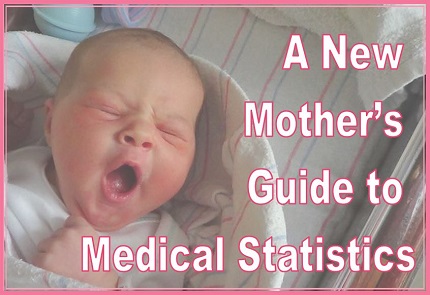
| Print | Back |  |
February 02, 2015 |
 |
Cookies and Pi A New Mother's Guide to Medical Statisticsby Sydney Bone |

I consider myself to be a fairly logical person. You don’t get an engineering degree without being able to work your way around complex mathematics and reasoning. However, that didn’t stop me from bawling like an idiot into a tub of ice cream when I was still pregnant on my due date.
Statistics and pregnant women don’t mix. I don’t mean like oil and water. They can physically be in the same place, but when they do, tears tend to be the end result.
About three weeks before my due date, I found this website that reports your likelihood of going into labor on any given day, based on your due date. Every night before we went to sleep, I’d tell my husband something along the lines of, “There’s a 3.8 percent chance I’ll go into labor tomorrow, and a 19 percent chance it’ll happen within a week.”
Of course, that meant there was an eighty-one percent chance I’d still be pregnant a week later. Or, as I saw it, eighty-one out of a hundred other women with my due date would still be pregnant. I was sure to be one of the nineteen lucky ones.
It is human nature to be overly optimistic about that sort of thing. You have effectively zero chance of winning the lottery, but someone wins, so people keep buying tickets.
Of course, in my defense, any baby born after the due date is considered late. The entire medical community seemed to be telling me that I would probably have my baby on or before June 22, 2013. Popular opinion agrees. We spent part of my due date with some of Jarret’s fellow interns. They asked when I was going to have the baby. I told them, “Well my due date is today,” and a few people freaked out.
One girl told me, “Just so you know, I’m not prepared to help deliver the baby if you go into labor right here.”
Most of their experiences with pregnancy and children came from Hollywood. Here’s how it goes down on screen: if a character is pregnant, she will not give birth in a hospital. Labor will come on suddenly and be over in twenty minutes. The baby will be delivered on the side of the road. There will be lots of blood and screaming. The comic relief character will probably faint or almost drop the baby.
In real life, everything but the blood and screaming is fairly unlikely to happen. Yet these peculiar, traumatic births are presented as the norm. This time, when statistics are misinterpreted, the culprit isn’t hormones, but Hollywood’s desire for drama.
Of course, the media can get away with this because of the unpredictability of pregnancy. The concept of a 40-week pregnancy is based on the averages. Half of all babies are born before their due dates, while the others are “late.” This methodology helps doctors make accurate assumptions about their patients and provide high quality medical care.
However, it is also responsible for plenty of sobbing pregnant woman. Maybe the dairy industry is behind it — a sinister plot designed to increase the sales of rocky road ice cream.
After Emy was finally born (a full four days after she was due) the hospital staff gave me an overwhelming amount of information designed to help me take care of this sweet, helpless new baby.
One thing they drove home was the importance of preventing Emy from sleeping on her stomach, in order to avoid Sudden Infant Death Syndrome (SIDS). I heard statistics like, “More than 2,000 babies died of SIDS in 2010,” (source: https://www.nichd.nih.gov/sts/about/SIDS/Pages/fastfacts.aspx), and I was terrified.
I would wake up to feed Emy at night, and then I would lie awake for hours worrying that she was going to stop breathing at any second. Logically, I understood that was unlikely, but logic and hormones don’t get along.
And it wasn’t until much later that I discovered just how uncommon SIDS is. According to the CDC, SIDS occurs in fifty-five out of every one hundred thousand live births. (source: http://www.cdc.gov/sids/data.htm) That is only 0.055 percent! Furthermore, certain factors like premature birth or secondhand smoke increase the risk of SIDS.
Sudden Infant Death Syndrome is a major concern to the pediatric medical community. And the parent education campaigns of the past twenty years have significantly reduced this problem. However, parents of infants at low risk for SIDS should relax a little. Follow the doctor’s instructions, but then breathe easy.
We don’t lie awake at night worrying about lightning strikes or giant squid attacks. Nor should we let concern about SIDS and other low frequency medical conditions prevent us from getting the rest we need. I made that mistake once, and I hope I’ll never do it again. Worst comes to worst, I’ll buy a baby breathing monitor.
Parenting is difficult. Fortunately, due to advancing knowledge and improved living conditions, most of our children will survive to adulthood, even if we do not worry about what the statistics have to say.
Medical statistics are valuable tools. This does not mean they are perfect or infallible. And we should be cautious before mixing them with our emotions.
| Copyright © 2024 by Sydney Bone | Printed from NauvooTimes.com |